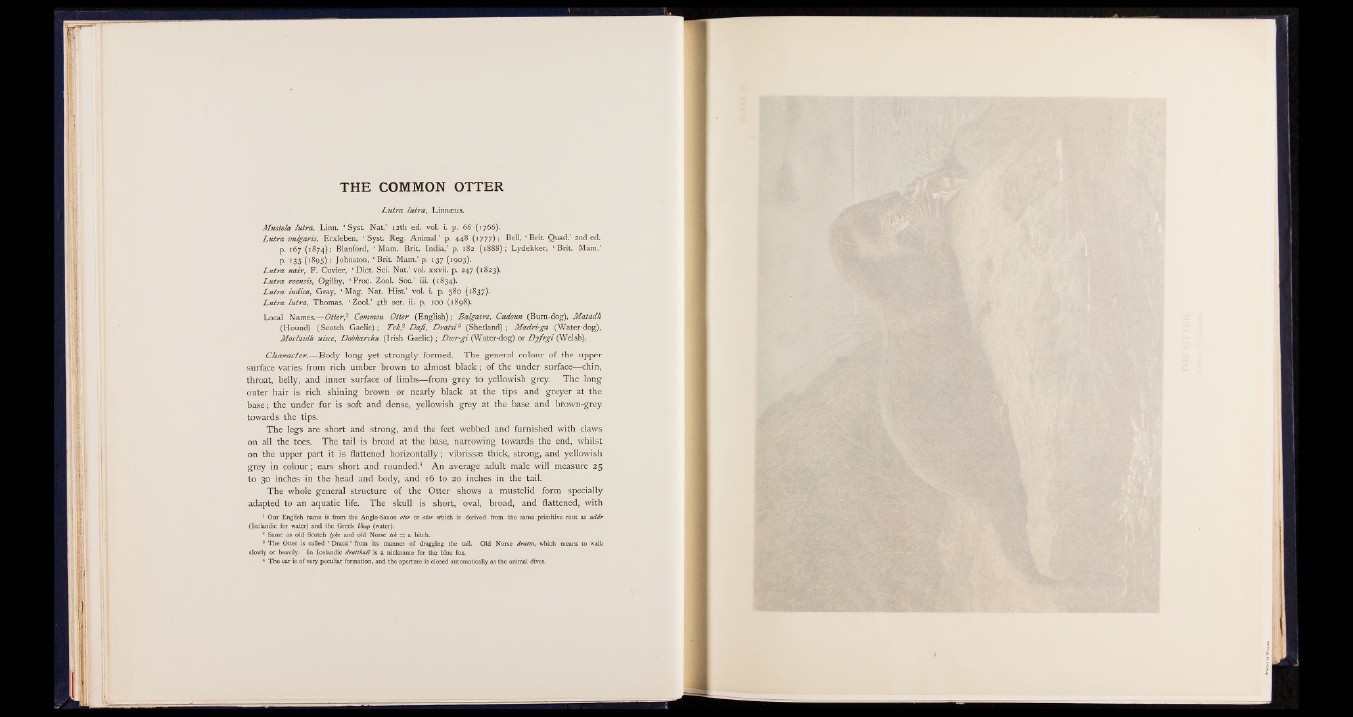
THE COMMON OTTER
Lutra lutra, Linnaeus.
Mustela lutra, Linn. * Syst. Nat.’ 12th ed. vol. i. p. 66 (1766).
Lutra vulgaris, Erxleben, ‘ Syst Reg. Animal.’ p. 448 (1777); Bell, ‘ Brit. Quad.’ 2nd ed.
p. 167 (1874); Blanford, ‘ Mam. Brit. India,’ p. 182 (1888); Lydekker, ‘ Brit. Mam.’
p. 135 (1895); Johnston, ‘ Brit. Mam.’ p. 137 (1903).
Lutra fiair, F. Cuvier, ‘ Diet. Sei. Nat.’ vol. xxvii. p. 247 (1823).
Lutra roensis, Ogilby, ‘ Proc. Zool. Soc.’ iii. (1834).
Lutra indica, Gray, ‘ Mag. Nat. Hist.’ vol. i. p. 580 (1837).
Lutra lutra, Thomas, ‘ Zool.’ 4th ser. ii. p. 100 (1898).
Local Names.—Otter,1 Common Otter (English); Balgaire, Cudoun (Burn-dog), Matadh
(Hound) (Scotch Gaelic); Tek? Dafi, Dratsi3 (Shetland) ; Madri-ga (Water-dog),
Maclaidh uisce, Dobharchu (Irish Gaelic) ; Dwr-gi (Water-dog) or Dyfrgi (Welsh).
Character.—Body long yet strongly formed. The general colour of the upper
surface varies from rich umber brown to almost black; of the under surface—chin,
throat, belly, and inner surface of limbs—from grey to yellowish grey. The long
outer hair is rich shining brown or nearly black at the tips and greyer at the
base; the under fur is soft and dense, yellowish grey at the base and brown-grey
towards the tips.
The legs are short and strong, and the feet webbed and furnished with claws
on all the toes. The tail is broad at the base, narrowing towards the end, whilst
on the upper part it is flattened horizontally; vibrissas thick, strong, and yellowish
grey in colour; ears short and rounded.4 An average adult male will measure 25
to 30 inches in the head and body, and 16 to 20 inches in the tail.
The whole general structure of the Otter shows a mustelid form specially
adapted to ah aquatic life. The skull is short, oval, broad, and flattened, with
1 Our English name is from the Anglo-Saxon oter or otor which is derived from the same primitive root as uddr
(Icelandic for water) and the Greek vSu>p (water).
2 Same as old Scotch tyke and old Norse tik = a bitch.
3 The Otter is called ‘ Dratsi ’ from its manner of dragging the tail. Old Norse dratia, which means to walk
slowly or heavily. In Icelandic dratthaU is a nickname for the blue fox.
* The ear is of very peculiar formation, and the aperture is closed automatically as the animal dives.